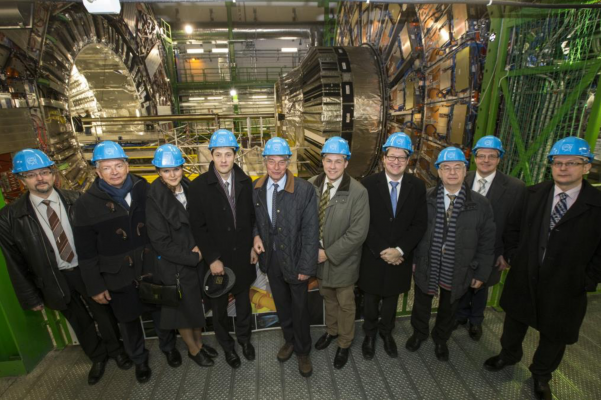
Delegation of Riga Technical University visit CERN, 21.01.2015.
Photo: CERN
The collaborative relationship between Latvia and CERN has been developing gradually and in several fields of research in parallel. Historically, besides high-energy physics, the collaboration has covered a wide range of topics, including the accelerator and detector research and development (R&D), mechanical and electrical engineering, robotics, computing and data processing.
History of Latvia’s relations with CERN and the participation in CERN programs
Latvia has had a long-standing tradition of cooperation with CERN and its experiments. Since Latvia regained its independence in 1990, there have been several scientific cooperation projects between Latvian research institutes and a variety of CERN-based collaborations, experiments and projects. For instance, in the early stages of the CMS experiment in 1996, the Institute of Electronics and Computer Science – at that time as part of the Latvian Academy of Sciences – contributed to the development of the software algorithms for its Hadron Calorimeter tracker.
In 2000, the Institute of Solid-State Physics (ISSP), of the University of Latvia (UL), joined the Crystal Clear Collaboration (CCC) and participated in the development of scintillation detectors made of BGO and PbWO4. These were later chosen as the sensing materials in the CMS detector systems. The ISSP re-established its active participation in the CCC in 2018 and today is providing a valuable contribution to its work.
Since 2005, the Institute of Physics (IP) of UL, with its expertise in liquid-metal pumps used for the ISOLDE targets, is an active member of the ISOLDE-based LIEBE Collaboration. From 2005 to 2008, Riga Technical University (RTU) and the Institute of Mathematics and Computer Science of UL, were members of the BalticGrid and directly contributed to the CERN computing.
In 2012, CERN signed the collaboration framework agreement with a key research and technology institution of Latvia – RTU. This provided a fresh impetus and opened new avenues for Latvian engagement with CERN. For example, in 2015, RTU joined the Future Circular Collider (FCC) study and, in 2017, the CERN coordinated ARIES project. Furthermore, based on this agreement, in 2015, an RTU PhD student of high-energy physics joined the CERN Experimental Physics Department and the CMS Physics, Software & Computing Group, and successfully developed and defended his research thesis in the field of top quark physics.
Continuing its fruitful collaboration with CERN, in 2017, RTU started to deploy its scientific staff to full-time work at CERN. In 2017, Latvian Consortium of RTU and UL joined CMS experiment, and in 2018 the CERN Baltic Group (CBG) was established.